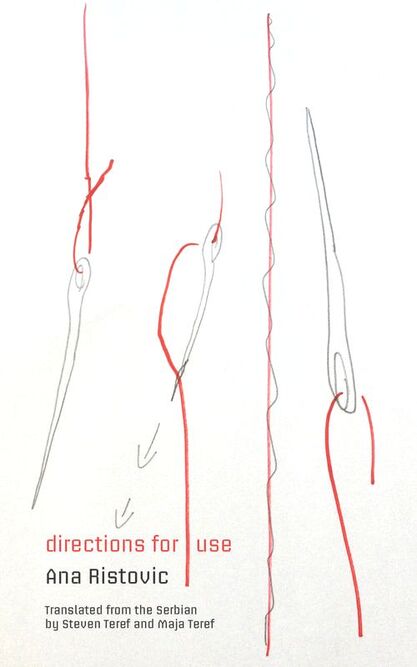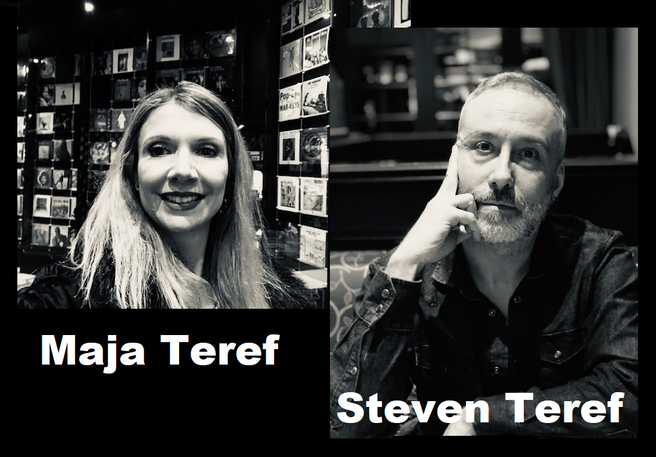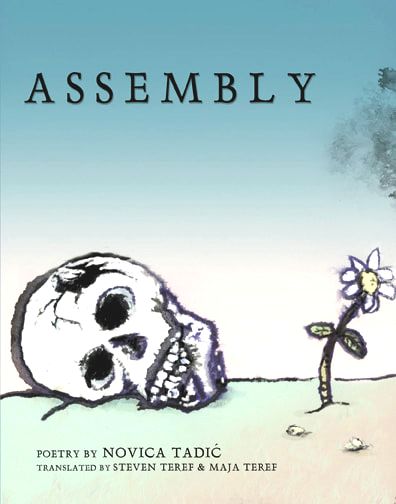|
I translate:
They are two types of translations; however, the both are utilized by Steven & Maja Teref mentioned in their craft essay. [A]s translators, it is our job to move the “data” and “information” of the source text to help the reader make sense or gain “knowledge” about a text, and we hope that by anchoring the music of the text in fixed English syntax, we have generated a blueprint for the reader to understand and enjoy it. That beautifully explains what translators do with their works. For my two translation works:
The translators build a bridge from the original written text to the readers who may live in a different time & place. Steven & Maja Teref have been perfecting their translation method together as a married couple. They translate from Bosnian, Croatian, and Serbian to English. It is a bit north of Croatia, but it was in Czechia that Kelcey Parker Ervick found inspiration for her book. It is a biographical collage (mixed with texts, footnotes, fragments, and images) entitled "The Bitter Life of Božena Němcová: A Biographical Collage". In today's craft essays, there are some original languages, and they remind me of texts from Parker Ervick's book. She also joined the graphic poetry audio exhibition. Craft Essays by Collaborated Artists in the Working On Gallery: Gail Goepfert x Patrice Boyer Claeys
Onetime, I asked Steven & Maja Teref how they find words? They immediately said, "Like when we do dishes?" I remembered that I thought about how romantic it is to search for one exact word after dinner, doing dishes, and wiping off plates together. It was just an envious moment for artists who have each other to achieve the same goal; in addition, the chores are also done. Two birds with one stone! I could image them working together, as if on an assembly line - - dirty plates into soapy water, brush, rinse, & wipe with a dried towel (with yellow & dark green flower prints of course) - - in smooth motions, they found a particular word for their particular poetic line. So, I would like to ask you today to read the following craft essay while imaging them at their dining table. Dust in the Sunlight: Translating Light by Steven Teref and Maja Teref Literary translation is the seeking of a text’s light. The more difficult the text, the more difficult to see its light. Imagine a sunshaft through a skylight window, the soft heat stirring the air. In the updraft, dust motes clot the light. Imagine this dustlight as the difficult parts of a text. The more difficult the text, the more backscatter. To translate a text is to translate its light. Each writer we choose to translate comes with challenges, but our end goal remains the same: the reader has to see the writer. The most difficult writer by far for us has been our latest project: translating MID (pronounced “mead”), the nom de guerre of Mita Dimitrijević, the most enigmatic character of a group of 1920s Yugoslav avant-gardists who referred to themselves as zenithists. He is such an obscure figure that when Belgrade, Serbia recently mounted an exhibition this year in celebration of the hundred-year anniversary of the short-lived movement, MID’s presence was conspicuously absent. MID would seem to be the backscatter of zenithism. For context, zenithism was a unique literary and art movement in the crowded field of 1920s avant-garde Europe on numerous fronts because it was a cross-genre movement on two levels: it synthesized the various separate avant-garde tendencies into one aesthetic, and it embraced hybrid writing as a central tenet of its poetics. From the word-packed panels (like action-packed film frames) of Ljubomir Micić’s Your Hundred Gods Be Damned to the Dada-leaps of Marijan Mikac’s poetry in Effect on Defect to the cinematic jump-cut landscape of Yvan Goll’s long poem Paris Burns to the tragi-comic expressionist-proto-surrealist novel of Poljanski’s 77 Suicides, each zenithist scattered the light. And then there is MID. MID was so ahead of his time that his time is yet to come. His omission at the zenithism retrospective this year confirms it. MID published two books with the zenithists: The Sexual Equilibrium of Money (1925) and The Metaphysics of Nothing (1926) before seeming to drop off the face of the earth. We have translated the former, a work as innovative in 2021 as it was when first published. What makes MID so difficult to translate, what makes his work so buried in dustmurk is the density of his metaphoric language and the allusions worming through his work. Yes, his work flips from prose to verse and from Dada to surrealism, but that’s child’s play for him. For a text punctuated, at times, by nearly empty pages, Sexual Equilibrium of Money is a dense work. Its alternation of word-bursting pages and ellipsis-strafed pages makes the work a dynamic feast as much for the eyes as for the mind. On its surface, it seems as if each page follows its own set of rules independent of the other pages. Is the work fiction? Poetry? A philosophical treatise? A collage? Found text? Is it even about money? Yes, all of the above. It is as much about economics as it is about Yugoslav identity, European politics, Kantian philosophy, the opposing natures of God and Jesus, the nature of nothing. Added to the mix were editorial errors such as cited text missing closing quotation marks. This isn’t to say that the book doesn’t have structure. The book is formally split between the verso and recto pages. The unnumbered verso pages generally repeat the word “KEY,” but the word degrades as the book progresses. The recto pages, their page count in descending order, can very loosely be chunked into four sections:
This is not a well-established theorized structure, since there has yet to be much literary criticism on MID, but this helped us understand how to approach MID’s esoteric text. The allusions are more times than not uncited or intentionally mis-cited. For instance, MID inserts a German translation of Hamlet’s famous line, “To be, or not to be” and attributes it to Schopenhauer! It must be noted that the verso pages begin with the declaration: “STEAL FREELY!” MID did this with aplomb. For all of the seemingly random quotes and concepts, the book is anchored in numerous refrains, such as Kant’s “thing-in-itself” and the word nothing. We workshopped an excerpt of an early draft of our translation at a Third Coast Translators Collective workshop (TCTC), but our fellow translators were daunted and perplexed by what we thought was a comprehensible first draft. Despite our best efforts at the time, all they saw were the “dust motes” or what Toni Morrison would call “data” and “information,” but the reading of the text for them remained largely hindered by the lack of rhythm and structure of the English language. The feedback was insightful and unanimous—keep the strangeness, the oddity, but the connective tissue needs to be familiar; keep the Hegelian/Kantian diction but adhere to English syntax. We were still far from Laurence Perrine’s “cone of light” or the ability to have the reader cull some knowledge from the text. Not surprisingly, since Bosnian-Croatian-Serbian has a developed case system, it has an incredibly flexible word order, something that English, with its sparse case system, doesn’t have, which accounts for its dependency on fixed word order. To help the reader see what we saw meant that we needed to tame the word order and expand the “cone of light” so that the light can contain or encompass the dust motes within its shaft. To backtrack a little to elucidate our process, doing the “trot” (or “gloss”) of MID’s text, felt more like taming a wild horse, or translating the first, literal draft. Although this project was not our first rodeo, translating MID seemed impossible at first: tackling a hybrid text which reads like prose poetry written in finance jargon with Hegelian and Kantian reasoning and sentence structure, printed on invoice banking paper with pagination in descending order and with the refrain of difficult-to-translate, opposites, necessitated, first and foremost, a slow, close-reading and, more than anything else, thorough reading comprehension. As we hacked and combed through the text, we often thought of Toni Morrison’s essay “Unspeakable Things Unspoken” in which she cautions us all to be aware of the progression of understanding from data to information to knowledge to wisdom. We felt at times palpably stuck on data interpretation of recurring opposites, namely the pairing in the phrase lice i naličje, so much so that Morrison’s information stage didn’t even seem in the offing. In our pursuit of clarity and light, the genealogy of lice (face, front, obverse) and naličje (back, reverse) took us from “reverse and obverse,” and “heads and tails” to “front and back,” “face and back,” “outside in and inside out,” “overt and covert,” “seen and unseen,” “visible and invisible,” or “recto and verso,” but through this journey, we began to gain some knowledge on how to think about his dust-thick work by trying to live in MID’s head. It became clear MID was satirizing the deceptively balanced yet hopelessly elusive, unjust Kafkaesque world of finance. The absurdity of his refrains started to sing for us, and we began to laugh with him. Yes, he was playing with the reader, much like a master Dadaist, but there was a logic underpinning his argument, as arcane as it was, so we also had to follow his clues. One allusive sentence in particular stood out: “Arius of Alexandria preached that the first perfect creation was dead matter (+), a ‘thing-in-itself:’ a WORD created from NOTHING: an eternal, self-important, UNCREATED divinity (–).” Up to the TCTC workshop, we had been only able to see the dust and not the light of the text. But for all of MID’s dust, he leaves hints of light. The dichotomy is not the front and back of a bill but the dual nature of nothing. Arius argued that Jesus had a distinct corporeal beginning and end that could be seen—he came from nothing and was therefore not eternal. Whereas God, without beginning and without end, cannot be seen and is eternal. This idea of being seen or not seen, coupled with numerous quotes with the word nothing, seemed central to understanding the work as a whole. The Sexual Equilibrium of Money is not a religious treatise, but the religious conceit serves as one of many conceits driving MID’s exploration on the nature of currency. In fact, the book, like its companion, is an early example of conceptual writing. If there was a single key to unlocking the cryptic secrets of Sexual Equilibrium, this sentence seemed as likely a candidate. If nothing else, it allowed us to find a way to make sense of the recurring references to “thing-in-itself” and “nothing” in relation to lice i naličje. As a result, we eventually landed on the “seen and unseen” as perhaps the best solution. Part of what makes translating MID so difficult is that there has yet to be extensive scholarship on his work. Working with Columbia University scholar Aleksandar Bošković, we’ve been able to decode many of MID’s allusions and make sense of his logic, and as a result, untangle his syntax into recognizable English-language sentence structures. The Sexual Equilibrium of Money will appear in the forthcoming Zenithism (1921–1927): A Yugoslav Avant-Garde Anthology on Academic Studies Press in 2022. To return, once again, to Morrison’s essay which we have applied to translation, as translators, it is our job to move the “data” and “information” of the source text to help the reader make sense or gain “knowledge” about a text, and we hope that by anchoring the music of the text in fixed English syntax, we have generated a blueprint for the reader to understand and enjoy it. And as for Morrison’s explanation of “wisdom,” it is our hope that our reader’s experience of MID’s text will better illuminate the world around them having read this translation. Maja Teref and Steven Teref translate from Bosnian, Croatian, and Serbian. Their books include Novica Tadić's Assembly and Ana Ristović's Directions for Use, the latter of which was shortlisted for the National Book Critics Circle Award, Best Translated Book Award, and the National Translation Award.
Maja is a past president of Illinois TESOL. She teaches English at the University of Chicago Laboratory Schools where she is also the faculty advisor for Ouroboros Review, a student-run literary translation journal. Steven's other books include Foreign Object, Pleasure Objects Teaser, and The Authentic Counterfeit. He is currently coediting with Aleksandar Bošković Zenithism: A Yugoslav Avant-Garde Anthology (1921–1927) (Academic Studies Press, 2022). Comments are closed.
|
Archives
July 2024
|
フジハブ
Welcome to FUJI HUB: Waystation to Poetry, Art, & Translation. This is not your final destination. There are many links to other websites here, so please explore them!
Welcome to FUJI HUB: Waystation to Poetry, Art, & Translation. This is not your final destination. There are many links to other websites here, so please explore them!
What are you looking for?
FUJI HUB Directory
Popular Sites:
Gallery of Graphic Poems
Working On Gallery
(Monthly New Article by Writers & Artists)
About Naoko Fujimoto
Contact
Naoko Fujimoto Copyright © 2024
FUJI HUB Directory
Popular Sites:
Gallery of Graphic Poems
Working On Gallery
(Monthly New Article by Writers & Artists)
About Naoko Fujimoto
Contact
Naoko Fujimoto Copyright © 2024





